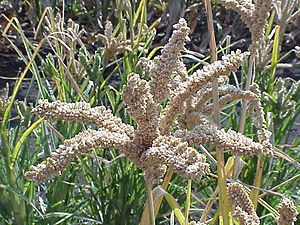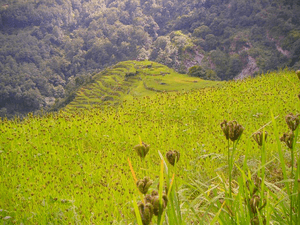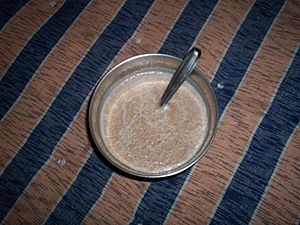Finger millet facts for kids
Quick facts for kids Finger millet |
|
|---|---|
 |
|
| Scientific classification | |
| Genus: |
Eleusine
|
| Species: |
coracana
|
| Synonyms | |
|
|
Finger millet (scientific name: Eleusine coracana) is a type of cereal grain. It is also known as ragi in India and kodo in Nepal. This plant grows every year and is widely farmed in dry and semi-dry areas of Africa and Asia.
Finger millet likely developed from its wild relative, Eleusine africana. It is special because it can grow well in high places, even over 2000 meters (about 6,500 feet) above sea level. It can also handle dry weather very well, and its grains can be stored for a long time.
Contents
- History of Finger Millet
- About the Finger Millet Plant
- Where Finger Millet Grows
- What Finger Millet Needs to Grow
- How Finger Millet is Farmed
- Weeds Affecting Finger Millet
- Diseases and Pests
- How Finger Millet is Planted
- Harvesting Finger Millet
- Storing Finger Millet
- Processing Finger Millet
- Uses of Finger Millet
- How Finger Millet is Prepared as Food
- Gallery
- See also
History of Finger Millet
Finger millet first came from the highlands of Ethiopia and Uganda in East Africa. The oldest proof of finger millet being grown dates back to the 8th century AD in Africa.
About the Finger Millet Plant
There are ten different types of plants in the Eleusine family. Scientists believe that Eleusine coracana (finger millet) came from two other types, E. indica and E. floccifolia. It was then chosen and grown from its wild form, E. Africana.
Where Finger Millet Grows
Finger millet is mostly grown in countries in Eastern and Southern Africa. These include Uganda, Kenya, the Democratic Republic of the Congo, Zimbabwe, Zambia, Sudan, Tanzania, Nigeria, and Mozambique. It is also grown in Southern Asia, especially in India and Nepal.
What Finger Millet Needs to Grow
Finger millet is a "short-day plant." This means it grows best when it gets about 12 hours of daylight. It usually grows in tropical areas that are dry or semi-dry. However, it can also be found growing in the Himalayas (India and Nepal) at higher altitudes.
This crop is known for handling dry conditions well. But compared to other millets like pearl millet and sorghum, it prefers a bit more rain, around 500 millimeters (20 inches) each year. Most farmers grow finger millet using only rainwater. However, yields can be much better with extra watering.
Finger millet can handle heat well. For example, in Uganda, it grows best at about 27 °C (81 °F). The temperature should not drop below 18 °C (64 °F). It can also handle cooler temperatures better than some other grains. It grows from about 500 to 2400 meters (1,600 to 7,900 feet) above sea level. This means it can be grown in higher places than most other tropical crops.
Finger millet can grow in many types of soil. This includes tropical soils that are very old and weathered. It can also handle some salty soils. It doesn't like too much water, so good drainage is important. It can grow in soils that are a little acidic (pH 5) or a little alkaline (pH 8.2).
How Finger Millet is Farmed
Often, finger millet is grown by itself in drier parts of Eastern Africa. Farmers also commonly grow it with other plants, like cowpea or pigeon pea, which are types of legumes. This is called intercropping. In Central Africa, finger millet is sometimes grown with cassava, plantain, and vegetables.
In South India, common ways to intercrop finger millet include:
- With legumes: Finger millet with dolichos, pigeonpea, black gram, or castor.
- With other grains: Finger millet with maize, foxtail millet, jowar, or little millet.
- With other plants: Finger millet with brassicas or mustard.
Weeds Affecting Finger Millet
Weeds are a big problem for growing finger millet. Its seeds are very small, so the young plants grow slowly. This makes it hard for finger millet to compete with weeds for sunlight, water, and nutrients.
In Africa, a plant called Eleusine indica (also known as Indian goose grass) is a serious weed. It looks very similar to young finger millet plants, especially when seeds are scattered instead of planted in rows. Other important weeds include Xanthium strumarium, Cyperus rotondus, and Cynodon dactylon.
Farmers use different ways to control weeds:
- Cultural methods: Planting seeds in rows instead of scattering them makes it easier to tell the difference between finger millet and weeds. The ICRISAT suggests using cover crops and crop rotations to stop weeds from growing.
- Physical methods: In places where farmers don't have many tools, they often remove weeds by hand or with a hand hoe.
Diseases and Pests
Finger millet is generally strong against diseases and pests. However, a disease called finger millet blast, caused by a fungus named Magnaporthe grisea, can cause a lot of damage. In Uganda, this disease has sometimes led to 80% of the crop being lost. The fungus makes leaves dry out and causes rot in the plant's neck and ears. This can stop the plant from making food and filling its grains, which reduces the harvest.
Finger millet blast can also infect other weeds that are related to finger millet. Farmers can control this disease by:
- Cultural measures: Rotating crops with plants that don't get the disease, deep plowing to bury infected plant parts, cleaning tools, controlling weeds, and not planting too many plants close together.
- Chemical treatments: Spraying fungicides or treating seeds with fungicides.
- Resistant varieties: Using types of finger millet that are naturally strong against the blast disease.
Another problem is a parasitic weed called Striga. It can reduce finger millet yields by 20% to 80%. Controlling Striga can be done by hand weeding, using herbicides, rotating crops, improving soil health, intercropping, and using biological controls. Scientists are working to find finger millet types that are resistant to Striga.
A fungus called Helminthosporium nodulosum can also cause leaf blight on finger millet.
Common pests include birds like quelea in East Africa. The pink stem borer (Sesamia inferens) and the shoot fly (Atherigona milliaceae) are important insect pests. Farmers can control these insects by removing infected plants, destroying plant remains, rotating crops, using insecticides, or using natural enemies of the pests.
How Finger Millet is Planted
Finger millet is mostly grown from seeds. In areas where farmers rely on rain, there are four main ways to plant:
- Broadcasting: Seeds are simply scattered over the field. This is easy and doesn't need special machines. However, it makes it hard to remove weeds because it's tough to tell the difference between young millet plants and weeds.
- Line Sowing: Seeds are planted in neat rows. This makes it easier to manage weeds because you can see the rows of crops. Farmers usually leave 22 to 30 cm (9-12 inches) between rows and 8 to 10 cm (3-4 inches) between plants in a row. Seeds should be planted about 3 cm (1 inch) deep.
- Drilling in rows: Seeds are planted directly into the soil using a special machine called a direct-seed drill. This method is used in farming practices that aim to protect the soil.
- Transplanting seedlings: Young finger millet plants are first grown in special nursery beds. After about four weeks, these young plants are moved and planted into the main field. This method needs the beds to be level and watered.
Harvesting Finger Millet

Finger millet does not ripen all at the same time, so it is usually harvested in two steps.
The first harvest happens when the main seed head and about half of the other seed heads on the plant turn brown. At this time, farmers cut off all the brown seed heads. These are then dried, threshed (to separate the grains), and cleaned.
The second harvest takes place about seven days later. All remaining seed heads, even the green ones, are cut. These grains are then "cured" to help them ripen. This means piling the harvested heads in the shade for a day without drying them. This increases humidity and temperature, helping the grains mature. After curing, they are dried, threshed, and cleaned just like the first harvest.
Storing Finger Millet
Once harvested, finger millet seeds store very well. They are rarely attacked by insects or mold. Unthreshed finger millet can be kept for up to 10 years. Some reports even say it can be stored for up to 50 years if kept in good conditions. This long storage time makes finger millet a very important crop for communities to rely on, especially in case of food shortages.
Processing Finger Millet
Milling
The first step to process finger millet is to grind it into flour. However, finger millet is hard to mill because its seeds are small. Also, the outer layer (bran) is very tightly stuck to the inner part (endosperm). The delicate seeds can also get crushed during grinding. Because of these challenges, it's hard to make large machines for milling finger millet.
So, the main product is usually whole grain flour. This flour has a shorter storage time because it contains more oil. Also, it's not used as much in big food factories. Wetting the millet seeds before grinding helps remove the bran without damaging the rest of the seed. Small millet mills can also grind other grains like wheat and sorghum.
Malting
Another way to process finger millet is by making the seeds sprout, a process called malting. This is common when making drinks like beer. When finger millet sprouts, special substances called enzymes become active. These enzymes change starches into other carbohydrates, like sugars. Finger millet is good for malting. Malted finger millet can be used to make things like gluten-free beer or easy-to-digest food for babies.
Uses of Finger Millet
| Nutritional value per 100 g (3.5 oz) | |
|---|---|
| Energy | 1,597 kJ (382 kcal) |
|
75.1 g
|
|
| Dietary fiber | 3.5 g |
|
4.2 g
|
|
|
Protein
|
10.8 g
|
| Vitamins | Quantity
%DV†
|
| Thiamine (B1) |
35%
0.4 mg |
| Riboflavin (B2) |
6%
0.07 mg |
| Niacin (B3) |
38%
6 mg |
| Pantothenic acid (B5) |
26%
1.3 mg |
| Vitamin B6 |
28%
0.37 mg |
| Folate (B9) |
11%
42 μg |
| Vitamin E |
1%
0.11 mg |
| Vitamin K |
1%
0.8 μg |
| Minerals | Quantity
%DV†
|
| Calcium |
1%
14 mg |
| Iron |
30%
3.9 mg |
| Magnesium |
34%
119 mg |
| Manganese |
48%
1 mg |
| Phosphorus |
41%
285 mg |
| Potassium |
7%
224 mg |
| Sodium |
0%
4 mg |
| Zinc |
27%
2.6 mg |
| Other constituents | Quantity |
| Water | 8.7 g |
|
Full Report of USDA Database entry
|
|
| †Percentages estimated using US recommendations for adults. | |
Finger millet can be ground into flour and used to make cakes, puddings, or porridge. The flour is also used to make a fermented drink or beer in Nepal and parts of Africa. The plant's stalks (straw) are used as food for animals.
Nutrition
Millet flour is mostly carbohydrates (75%), with some protein (11%) and fat (4%). It also contains water (9%). A 100-gram (3.5 ounce) serving of millet flour gives you 382 calories. It is a good source of protein, dietary fiber, several B vitamins, and many dietary minerals. However, it doesn't have much calcium, potassium, or sodium.
Growing Finger Millet for Better Nutrition
The International Crops Research Institute for the Semi-Arid Tropics (ICRISAT) works with farmers, governments, and researchers. They help farmers grow nutritious crops like finger millet. This helps communities have healthier diets and become stronger against pests and dry weather. For example, a project called HOPE is helping farmers in Tanzania grow more finger millet by using better types of seeds.
How Finger Millet is Prepared as Food
In India
In India, finger millet, or ragi, is often malted (sprouted) and then ground into flour. This flour can be eaten with milk, boiled water, or yogurt. It is also made into flatbreads like thin dosa and thicker roti.
Many dishes are made from finger millet, including dosa, idli, and laddu. In southern India, doctors sometimes suggest finger millet for baby food. This is because it has a lot of iron and calcium. Common dishes include satva, pole (dosa), bhakri, ambil (a sour porridge), and pappad.
In Karnataka, finger millet is often eaten as a porridge called ragi mudde. This is a main food for many people in South Karnataka, especially in rural areas. Mudde is made by cooking ragi flour with water until it becomes a dough. It is then rolled into balls and eaten with sambar (huli), saaru, or curries. Ragi is also used to make roti, idli, dosa, and conjee. In the Malnad region of Karnataka, the whole ragi grain is soaked, and its "milk" is taken out to make a sweet dish called keelsa. A type of flatbread called ragi rotti is made from finger millet flour in northern Karnataka.
In Tamil Nadu, ragi is called kezhvaragu or keppai. It is dried, powdered, and boiled to form a thick mass called kali or keppai kali. This is shaped into balls and eaten with sambar or kuzhambu. For children, ragi is also mixed with milk and sugar. It can also be made into pancakes with onions and tomatoes. Kezhvaragu is used to make puttu with jaggery or sugar. Koozh, a simple ragi porridge, is a common food for farmers, eaten with raw onions and green chilies.
In Andhra Pradesh, ragi sankati or ragi muddha (ragi balls) are eaten in the morning with chili, onions, and sambar. In Kerala, puttu, a traditional breakfast dish, can be made with ragi flour and grated coconut, then steamed. In parts of Odisha, ragi or mandiaa is a main food. In the Garhwal and Kumaon regions of Uttarakhand, koda or maddua is made into thick rotis (served with ghee) and also into badi, a sweet dish. In Kumaon, ragi is traditionally given to women after childbirth. It's also used to make snacks like namkeen sev and mathri.
In South and Far East Asia
In Nepal, a thick dough called ḍhĩḍo is made from millet flour (kōdō) and eaten by hand. The dough can also be made into thick bread called rotee. Fermented millet is used to make a beer called chhaang, and the liquid is distilled to make a strong drink called rakśi. Whole grain millet is fermented to make tongba. In Nepal, the National Plant Genetic Resource Centre keeps many samples of Nepalese finger millet.
In Sri Lanka, finger millet is called kurakkan. It is made into kurakkan roti (a thick brown flatbread with coconut) and thallapa (a thick dough ball eaten with spicy meat curry). It is also eaten as a soup (kurrakan kenda) and a sweet called 'Halape'. In northwest Vietnam, finger millet is used as a traditional medicine for women after childbirth. Some people also use finger millet flour to make alcohol.
As a Beverage
Ragi malt porridge is made from finger millet that is soaked, dried in the shade, roasted, and then ground. This preparation is boiled in water and used as a healthy drink, sometimes instead of milk powder-based drinks.
Gallery
-
Idli, a South Indian breakfast dish made from ragi flour
See also
 In Spanish: Ragi para niños
In Spanish: Ragi para niños












